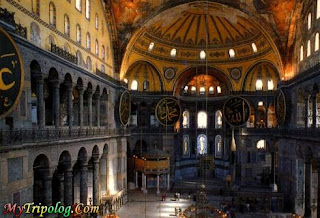 |
| HAGIA SOPHIA |
Hagia Sophia (from the Greek: Ἁγία Σοφία, "Holy Wisdom"; Latin: Sancta Sophia or Sancta Sapientia; Turkish: Aya Sofya) is a former Orthodox patriarchal basilica, later a mosque, and now a museum in Istanbul, Turkey. From the date of its dedication in 360 until 1453, it served as the cathedral of Constantinople, except between 1204 and 1261, when it was the cathedral of the Latin Empire. The building was a mosque from 29 May 1453 until 1934, when it was secularized. It was opened as a museum on 1 February 1935.
The Church was dedicated to the Logos, the second person of the Holy Trinity, its dedication feast taking place on December 25, the anniversary of the incarnation of the Logos in Christ. Although it is sometimes referred to as Sancta Sophia (as though it were named after Saint Sophia), sophia is the phonetic spelling in Latin of the Greek word for wisdom - the full name in Greek being Ναός τῆς Ἁγίας τοῦ Θεοῦ Σοφίας, "Church of the Holy Wisdom of God".
Famous in particular for its massive dome, it is considered the epitome of Byzantine architecture and is said to have "changed the history of architecture."[5] It was the largest cathedral in the world for nearly a thousand years, until Seville Cathedral was completed in 1520. The current building was originally constructed as a church between 532 and 537 on the orders of the Byzantine Emperor Justinian and was the third Church of the Holy Wisdom to occupy the site, the previous two having both been destroyed by rioters. It was designed by Isidore of Miletus, a physicist, and Anthemius of Tralles, a mathematician.
The church contained a large collection of holy relics and featured, among other things, a 49 foot (15 m) silver iconostasis. It was the seat of the Patriarch of Constantinople and the religious focal point of the Eastern Orthodox Church for nearly one thousand years. It is the church in which Cardinal Humbert in 1054 excommunicated Michael I Cerularius - which is commonly considered the start of the Great Schism.
In 1453, Constantinople was conquered by the Ottoman Turks under Sultan Mehmed II, who subsiquently ordered the building converted into a mosque. The bells, altar, iconostasis, and sacrificial vessels were removed and many of the mosaics were plastered over. Islamic features — such as the mihrab, minbar, and four minarets — were added while in the possession of the Ottomans. It remained a mosque until 1935, when it was converted into a museum by the Republic of Turkey.
For almost 500 years the principal mosque of Istanbul, Hagia Sophia served as a model for many other Ottoman mosques, such as the Sultan Ahmed Mosque (Blue Mosque of Istanbul), the Şehzade Mosque, the Süleymaniye Mosque, the Rüstem Pasha Mosque and the Kılıç Ali Paşa Mosque.
In 1453 Sultan Mehmed laid siege to Constantinople, driven in part by a desire to convert the city to Islam. The Sultan promised his troops three days of unbridled pillage if the city fell, after which he would claim its contents himself. The Hagia Sophia was not exempted from the pillage, becoming its focal point as the invaders believed it to contain the greatest treasures of the city. Shortly after the city’s defenses collapsed, pillagers made their way to the Hagia Sophia and battered down its doors. Throughout the siege the Holy Liturgy and Prayer of the Hours were performed at the Hagia Sophia, and the church formed a refuge for many of those who were unable to contribute to the city’s defense. Trapped in the church, congregants and refugees became booty to be divided amongst the invaders. The building was desecrated and looted, and occupants enslaved or slaughtered; a few of the elderly and infirm were killed, and the remainder chained. Priests purportedly continued to perform Christian rites until stopped by the invaders. When the Sultan and his cohort entered the church, one of the Ulama climbed the pulpit and recited the Shahada, transforming at once the church into a mosque.
Architecture
A section of the original architecture of Hagia Sophia
Groundplan of the Hagia Sophia one of the mighty stone columns with metal clasps
Hagia Sophia is one of the greatest surviving examples of Byzantine architecture. Of great artistic value was its decorated interior with mosaics and marble pillars and coverings. The temple itself was so richly and artistically decorated that Justinian proclaimed, "Solomon, I have outdone thee!" (Νενίκηκά σε Σολομών). Justinian himself had overseen the completion of the greatest cathedral ever built up to that time, and it was to remain the largest cathedral for 1,000 years up until the completion of the cathedral in Seville in Spain.
Justinian's basilica was at once the culminating architectural achievement of late antiquity and the first masterpiece of Byzantine architecture. Its influence, both architecturally and liturgically, was widespread and enduring in the Eastern Orthodox, Roman Catholic, and Muslim worlds alike. The largest columns are of granite, about 19 or 20 metres high and at least 1.5 metres in diameter; the largest weigh well over 70 tons apiece. Under Justinian's orders, eight Corinthian columns were disassembled from Baalbek, Lebanon and shipped to Constantinople for the construction of Hagia Sophia.
The vast interior has a complex structure. The nave is covered by a central dome 55.6 metres (182 ft 5 in) from floor level, supported in part by an arcade of 40 arched windows. Repairs to structure have left the dome somewhat elliptical - with the diameter varying between 31.24 m (102 ft 6 in) and 30.86 m (101 ft 3 in).
The dome is carried on four concave triangular pendentives that serve to transition from the circular base of the dome to its rectangular base. The weight of the dome passes through the pendentives to four massive piers at the corners; these were reinforced with buttresses during Ottoman times, under the guidance of the architect Mimar Sinan.
At the western entrance and eastern liturgical side, the arched openings are extended by half domes carried on smaller semi-domed exedras; a hierarchy of dome-headed elements built up to create a vast oblong interior, crowned by the main dome. Despite all of the aforementioned features, the weight of the dome remained a problem, requiring the addition of external buttresses.
Interior surfaces are sheathed with polychrome marbles, green and white with purple porphyry, and gold mosaics.
The exterior, clad in stucco, was tinted yellow and red during a restorations in the 19th century on the direction of the architect Fossati.







0 comments:
Post a Comment